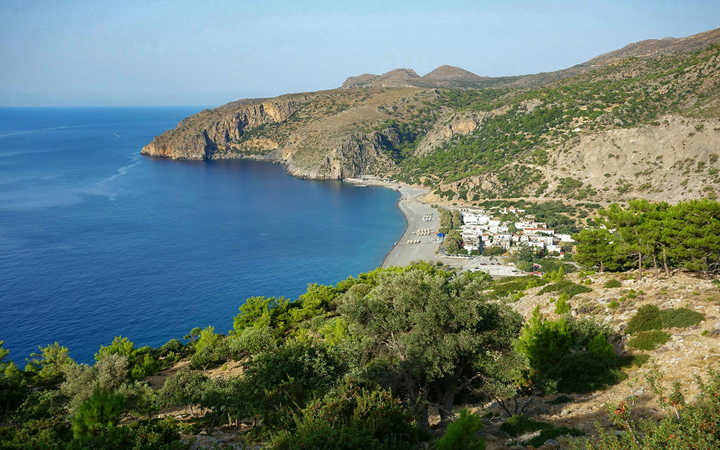About 20 kilometers from the southwest corner of Crete, Sougia belongs to Crete's less-crowded and in some ways more hip southern coast. Some people have been returning here from first-time visits dating back to the 1970's. This village of about 100 year-round residents is built on a small crescent-shaped littoral formed by the deposits of the river which carved out the Agia Irini gorge, which, running south, meets the sea at Sougia. The main road from Chania and other points north follow this gorge.
Locals believe that Sougia was the home of Homer's Cyclops, with whom Ulysses spent a fair amount of time before escaping with his men from the one-eyed monster's cave by clinging to the underside of Cyclops's sheep as they left the cave to graze for the day. Ask about it when you're there. Maybe someone knows where his cave is.
The road from Chania, 70 kilometers long, is both winding and scenic. The 90-minute trip takes you through orange, olive and lemon groves and compact little mountain villages before descending to sea level via the Agia Irini gorge, which begins, appropriately, just after the village of Agia Irini. Sougia is linked to Paleochora, about a half hour's drive west, by a paved road. Daily boats ply the shoreline between the two villages during the summer. Sougia has a cute little harbor about 50 meters across, about 500 meters west of the village.
History and Local Sights
Sougia was known in ancient times as a place where pigs were kept. Around the 7th century, BC it was a Dorian port for a population center in the mountains some 7 km to the north named Elyros, which today is called Rodovani, where, on Kefalas hill, the ancient ruins of the settlement can be found. Elyros was an important enough place to mint its own coins. The Saracens (Arabian Muslims), however, made ruins of it in the 800's AD. One can assume that the ancient port was where the littoral (on which the village was built) is now.
A place worth visiting in the village is the church of Agios Panteleimon on the west end, with its 6-century mosaic floor depicting plant and wildlife, including peacocks and flowers. Peacocks were a favorite subject of Byzantine art, and are thought to represent paradise, spring, and renewal. The church key can be found at the nearby kiosk.
There is a path leading, after a two-hour westerly hike, to the ruins of ancient Lissos, which was a second harbor for Elyros. The distance is only a couple kilometers in a straight line, but there is a fair amount of climbing up and down which lengthens the trip. It is considered a very pleasant and scenic hike. The boat to Paleochora stops there as well. In its day Lissos was well-known for its temple of Asklepios, and was a center of healing for pilgrims from all over Crete.
The little church of Agia Irini, off a path on the road up the gorge, offers a magnificent view of the sea, the village, and the surrounding countryside. You can also take the bus a half hour up the gorge to the village of Agia Irini, and walk down the gorge to Sougia, which takes about 4 hours.
On July 19th, the day before the feast day of the Prophet Elijah, the people of Sougia take the boat to Tripiti, to the east, climb 400 meters up to the chapel of the Prophet Elijah, and spend the night celebrating the prophet's feast day with music and food.
The Beach
The mixed sand and pebble, tamarisk tree-fringed beach is over a kilometer long, and there's always plenty of room to spread out. Hippie types have been camping out on the beach, especially on its east end, for decades, where some nude sunbathing takes place as well. Sougia has a lot of small, tourist-friendly businesses along the beach; snack bars, restaurants, kiosks, and small markets. A few bars offer quiet entertainment in the evening. This is not a loud nightlife place by any means.
Sougia is a peaceful, laid-back, live and let live kind of place, and perfect for a quiet getaway It is a place to relax, greet strangers in a friendly informal way, and absorb the healthy, arid climate.












